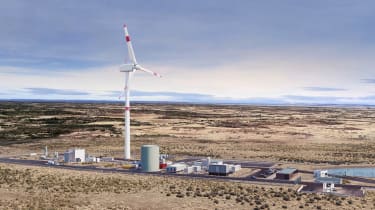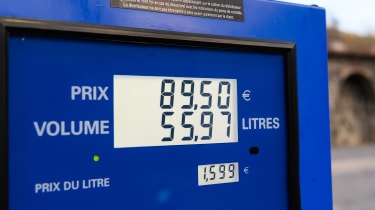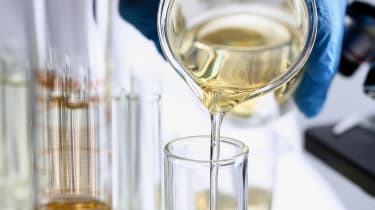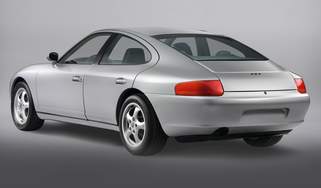Porsche to build second eFuel facility in Tasmania
Porsche and eFuels partner HIF to build second major facility, this one in Australia’s island state

Porsche and its eFuels partner HIF Global have announced the location of their latest manufacturing facility that’ll be able to produce up to 100 million litres of eFuel per annum from 2026. To be built on the North Western corner of Tasmania, Australia, it’ll join the Chile plant as a source for sustainable eFuels for use in its motorsport and dealership network operations before potentially being available to private customers in the future.
The factory’s location – putting to one side its economic benefits – is important due to the requirements of manufacturing eFuels that are truly carbon neutral. The ability to generate substantial and consistent renewable energy for its production is a key factor in creating what’s known as Green Hydrogen, a fundamental building block of creating sustainable fuels. Construction of the site is due to begin in 2024, with completion penned for mid-2026, where, when fully operational, will have a 100 million litre production capacity.
Porsche owns a 12.5 percent stake in its eFuels partner HIF Global, a holding company for a number of eFuel production facilities around the world, including both the Chilean and now this Australian site. Porsche, as well as its other technical partners, Siemens Energy and ExxonMobil have already embarked on eFuel production, but this latest investment will add much-needed scale to its pilot programs that are already producing fuel.
HIF will utilise Porsche’s investment, and that of three other investors, to bring the total round of funding raised to a low nine-figure sum in USD, expanding its operations within South America, the United States and Australia. In these locations, clean energy such as solar and wind provide the huge amount of renewable energy required to create low emission eFuels. The plant in Chile currently uses dedicated wind energy to produce its eFuel.
Porsche has had an interest in eFuels for a number of years, now utilising it for the company’s one-make Supercup championship cars in both testing and racing, with no detrimental impact on performance or engine life. The company also has ambitions to use synthetic fuels at its driving experience centres, and for every first full tank in all Porsche customer cars, even those built beyond 2030. That Formula 1 will run exclusively on eFuels from the 2026 season shouldn’t be ignored by those who link Porsche returning to single seater racing, too.
Synthetic fuel production remains in its infancy, however. The current Santiago de Chile facility won’t be operating at maximum capacity until 2025, at which stage it will be capable of producing in the region of 550 million litres a year. But while this new investment in HIF won’t increase production at the Chilean site, it will fund the development of new sites around the world, as well as speed up development, making the production processes required to synthesise eFuels more efficient and cost effective.
Away from automotive, Porsche is also in conversation with the aviation and marine industries, both of which have more pertinent need to find an alternative fuel to those they currently burn. A byproduct of eFuel production, E-methanol, is not only a possible replacement for the fuel currently used by the shipping industry, but also a suitable replacement for fossil fuels in the manufacture of other industrial materials, further reducing CO2 output.
eFuel – what is it, and why is it different?
This starts with the development of synthetic fuels such as the eFuel Porsche has developed and fellow VW Group members Audi and Bentley are contributing to, of which there are various types and with various applications. In some parts of the world, bio-fuels are already integrated into the current energy economy, with some nations, such as Brazil, running mostly on ethanol-rich mixes of E85 grade petrol and other nations introducing bio-diesels derived from organic sources such as corn or burning green waste.
Porsche has gone down a different and much cleaner route, creating a synthetic petrol from a combination of green hydrogen and pure carbon drawn through atmospheric carbon capture processes. The raw fuel created (eMethanol) from this process is then easily converted into high-octane fuels that are capable of being used in most petrol combustion engines now.
Porsche has already started construction of a pilot plant in southern Chile that will produce eFuel from as early as next year, with initial projections forecasting that the factory will be able to produce 130,000 litres in 2022, despite construction not planned on being completed until at least the middle of that year. Porsche plans to then quickly turn up production, estimating 55 million litres in 2023, and as much as 550 million in 2024.
How is it carbon neutral?
It’s important to emphasise that eFuels will not stop cars with combustion engines producing carbon emissions at the tailpipe. Like all petrol it undergoes a combustion process creating hydrocarbons, but unlike normal gasoline (which is based on fossil fuels therefore emitting carbon that was once locked away in oil reserves) eFuels emit largely the same carbon output as was absorbed by its production, making it ‘almost’ carbon-neutral.
Porsche says ‘almost’, as while its production and burn cancel each other out, shipping it from the source in Chile to its eventual use in Europe or the USA isn’t factored in CO2 output calculation yet. Porsche hopes the adoption of eFuel technology in shipping and transport, will decarbonise this last link in the chain.
How eFuels absorb carbon in the production process is all down to the science of precisely how their form of synthetic fuel is made. Step one is to create green hydrogen through a process of electrolysis. This process is very energy intensive, and when created from fossil fuel-sourced electricity doesn’t make ecological sense. The key difference with Porsche’s production is that the electricity used for this process is generated on-site by wind-turbines, one of the key reasons the plant’s location on the southern tip of Chile was chosen.
The hydrogen is then combined with pure carbon captured from the atmosphere to create e-methanol, which can then be quickly and easily converted into high-octane petrol. It’s this element of carbon capture that puts production into the negative in terms of emissions, with Porsche claiming that excluding transportation and shipping, the CO2 capture is almost completely balanced when burnt in a combustion engine.
Where and how it’ll be used, and how much will it cost?
Given so much fuel will soon be produced before limitations in global supply begin to emerge Porsche will initially use the fuel in its Formula 1-supporting 911 GT3 Supercup race series and after that its experience centres around the world including Silverstone, Le Mans and LA.
Looking further ahead, supply through Porsche centres or ‘lamp-post fillers’, or a partnered energy company with a fuel distribution chain already in place look to be the most likely avenues. In the long-term, this is how Porsche sees the future of running classic cars that are too valuable to take off the road entirely, both fiscally and sentimentally.
Porsche is adamant that this does not represent a turn back towards the combustion engine for its range, though, rather it’s supporting technology that will keep its heritage alive whilst pursuing its net carbon zero targets by the 2030 deadline, one it’s rightly proud of boasting will be before the benchmarks currently in place by the Paris climate agreement.
So how much will this all cost? Porsche has done the sums, and is projecting that as its costs go down, and the relative cost of fossil fuels go up (regardless of independent taxes or breaks in subsidisation) the two will overlap in price at about $2 US per litre by 2030. That, for context, is about the same price as standard fuel in the UK now!








